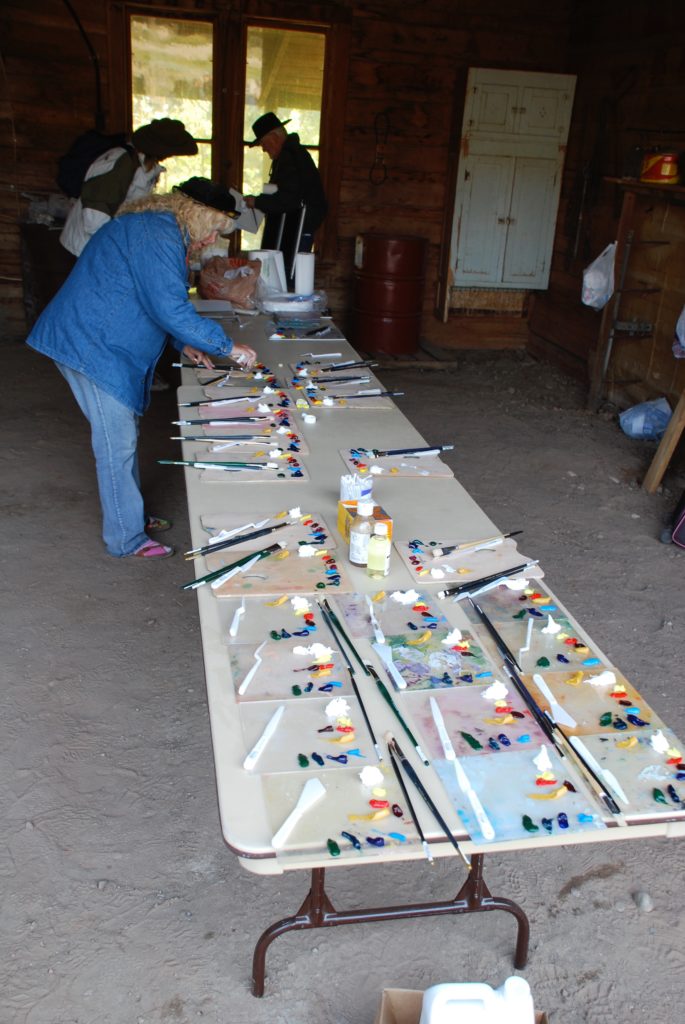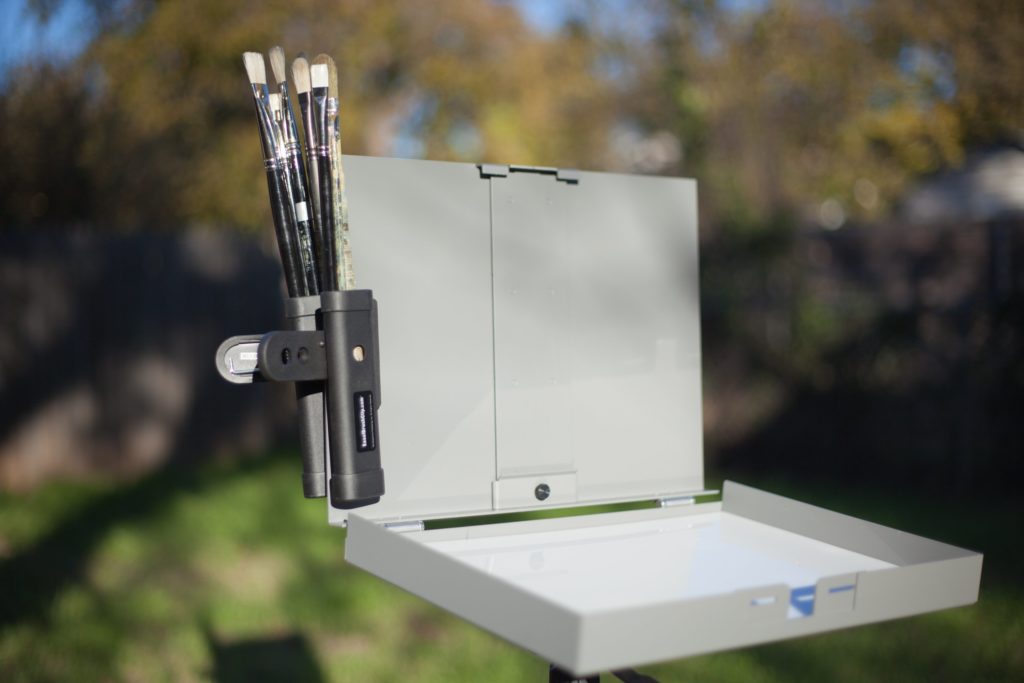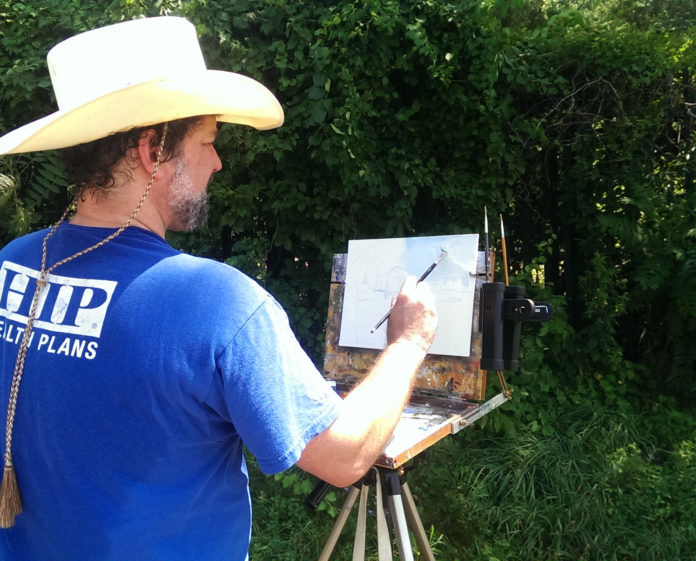The art of painting is a head game. It requires a distraction-free environment that allows you to get into the painting zone where things are going smoothly — distractions are the enemy. So what can an artist do to set him- or herself up for success?
Preparation and consistency are the key. And that starts with your color palette. Your palette needs to be like the keyboard of a piano, so you always dip into the same spot to find the same color. Colors should be laid out from warm to cool (ideally), with your white either in the middle or on an edge, but in the same place each time.
If you run out of a particular color, your paint tubes should be within easy reach and always returned to exactly the same place so you never have to spend time sorting through them. You can easily waste five minutes looking for a misplaced tube of paint. Many painters mark the colors over the drawer holding their paints, making it easy to find exactly what they need. Painters can pick up drawer organizers at bed-and-bath or container stores. And it’s a good idea to have a standardized palette so the most used colors are always easiest to access, though less frequently used “rogue” colors need to have their own places as well.
Many artists use a handheld palette so they can hold the palette up to match the mixture while looking at the subject or model, while others use a palette at the base of the easel or on a side table for mixing. There are a number of ways to get a palette into the same light plane as the painting. A parallel palette, which mounts next to the painting, makes it easy to mix on the same plane. Another option is to mount your handheld palette beside the painting, using a clip you can find at a hardware store. Unless your paint is very oily, it will not slip off or run.
Another item that can distract painters is a mahl stick (these are used to support the arm for strokes requiring a steady hand). Rather than setting aside a mahl stick and perhaps having to hunt for it, a loop can be added to the end and hooked on to the center of the easel. The stick can then easily be grabbed when needed. Storing it off to either side by resting it on a screw or eyelet also makes the stick easy to find and use.

Paper towels are also used by most artists. Some artists intentionally keep their towels at the back of the room so they’re forced to stop to get a fresh towel, giving them a chance to gain some distance and perspective. If you prefer to keep towels close, a simple bungee cord attached to your easel tray or an ordinary paper towel holder can be used on your easel. It’s important, however, that you store towels so they don’t restrict the movement of your easel if it needs to be lowered.
Just as paints and brushes always need to be in the same spot, your mineral spirits should always be in the same place so you can dip without looking. The ideal place for your mineral spirits or brush cleaner is hanging in a container from your easel — or some easels have cut-out holes to drop in a container. Medium cups are best stored on your palette or the tray of the easel.
Brush and palette knife organization is also critical. It’s important to anticipate the brushes you’ll need before you paint, so you don’t have to break your stride and spend time looking during active painting time.
How many times have you needed a specific brush for a particular purpose and been unable to find it? Soon you find yourself digging through piles of brushes seeking the right one. Though most artists keep a jar with a lot of brushes nearby, that can make it hard to find a particular brush quickly. Keep your brushes in view beside your painting, so you can grab exactly what you need at the moment you need it.

It’s also important to sort your brushes based on your style. For instance, some painters like to use clean brushes for certain passages so that a dirty brush doesn’t muddy a clean sky, or a light color pollute a darker one.
Other painters tend to keep separate brushes for cool colors and warm colors. They understand that putting a brush with a little warm paint residue into a cool color can spoil that color (the opposite is also true). Artists need an easy system to deal with warm/cool or clean/dirty brush issues to avoid polluting paint. Having the brushes you plan to use for a particular painting session right at hand saves time and distraction.
Though most easels have trays and most artists have a table or taboret to hold their palette, brushes, colors, and mineral spirits or water, these surfaces can easily become cluttered. Laying out brushes does make them much easier to find than keeping them in a big jar that has to be sorted through— but then, brushes are easily bumped and knocked off a table.
Dropping brushes while painting is also a common distraction. Bending down, or crawling on the floor or the ground seeking a lost brush, not only eats time, it breaks the artist’s concentration. And of course dropped brushes come back with dust (or dirt or mud if outdoors), and the brushes can be damaged if they fall on the hairs. A brush full of paint on the studio floor also means time spent cleaning up — and artists have been known to go to the floor or ground and bump their head or even knock the easel over when coming back up. (And of course some artists prefer to avoid bending to the ground entirely.)
A new product that has surfaced in the past year seems to help with brush management. The product, called an Easel Brush Clip, has two small square cups held together by a clip that attaches to the palette at eye level, next to the painting. Brushes can be found easily, and the two cups can be used to keep warm and cool brushes apart, or used and clean brushes. We’ve found that artists are placing a couple on each side of their easels.
This product also allows the painter to easily drop in a brush she intends to return to momentarily, so she doesn’t have to hold on to it, and it’s a natural place to put brushes rather than laying them down. And a side benefit is that it minimizes brush drops.
These are also popular with plein air painters who want to keep brushes off of small, often flimsy trays so they won’t fall on the dirty ground or roll into their paints. Further, the clips keep brushes in view — in plein air painting, finding a convenient place for brushes is always a challenge. Outdoor artists have also discovered the strong clip can be used to hold painting umbrellas and paint-rag bags. Artists are using these clips for their studios and as part of their outdoor painting rigs. They’re using them for brushes and palette knives, and even for storing items like eyeglasses.
Every artist develops a system of their own for managing their tools. What is most important is to find what works for you, and to keep things in exactly the same order every time, so your concentration is not broken and you’re not frustrated when you should be painting.




